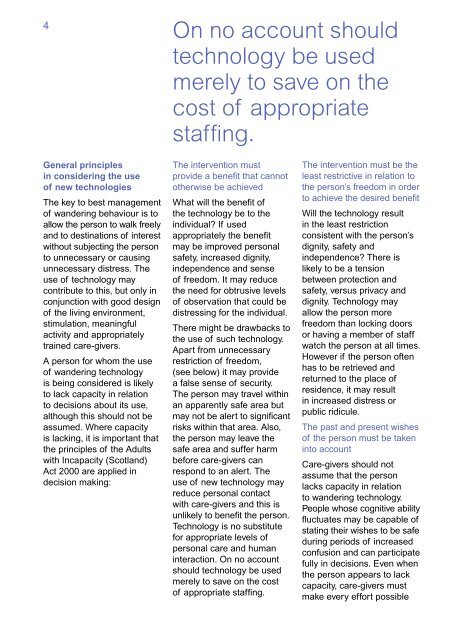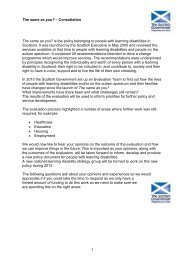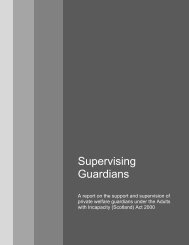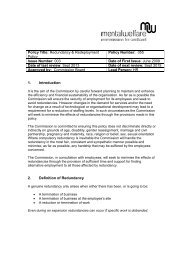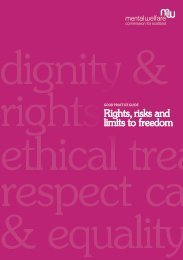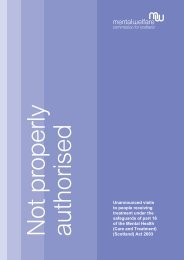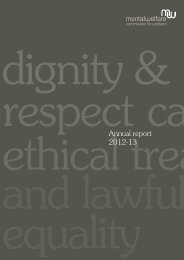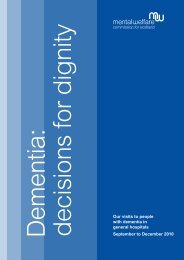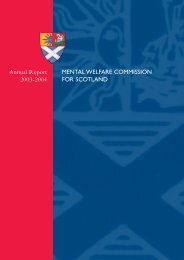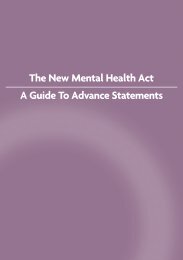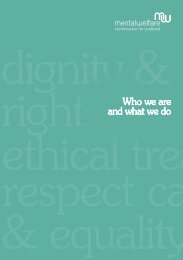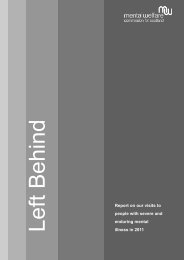Safe to wander - Mental Welfare Commission for Scotland
Safe to wander - Mental Welfare Commission for Scotland
Safe to wander - Mental Welfare Commission for Scotland
- No tags were found...
Create successful ePaper yourself
Turn your PDF publications into a flip-book with our unique Google optimized e-Paper software.
4On no account shouldtechnology be usedmerely <strong>to</strong> save on thecost of appropriatestaffing.General principlesin considering the useof new technologiesThe key <strong>to</strong> best managemen<strong>to</strong>f <strong>wander</strong>ing behaviour is <strong>to</strong>allow the person <strong>to</strong> walk freelyand <strong>to</strong> destinations of interestwithout subjecting the person<strong>to</strong> unnecessary or causingunnecessary distress. Theuse of technology maycontribute <strong>to</strong> this, but only inconjunction with good designof the living environment,stimulation, meaningfulactivity and appropriatelytrained care-givers.A person <strong>for</strong> whom the useof <strong>wander</strong>ing technologyis being considered is likely<strong>to</strong> lack capacity in relation<strong>to</strong> decisions about its use,although this should not beassumed. Where capacityis lacking, it is important thatthe principles of the Adultswith Incapacity (<strong>Scotland</strong>)Act 2000 are applied indecision making:The intervention mustprovide a benefit that canno<strong>to</strong>therwise be achievedWhat will the benefit ofthe technology be <strong>to</strong> theindividual? If usedappropriately the benefitmay be improved personalsafety, increased dignity,independence and senseof freedom. It may reducethe need <strong>for</strong> obtrusive levelsof observation that could bedistressing <strong>for</strong> the individual.There might be drawbacks <strong>to</strong>the use of such technology.Apart from unnecessaryrestriction of freedom,(see below) it may providea false sense of security.The person may travel withinan apparently safe area butmay not be alert <strong>to</strong> significantrisks within that area. Also,the person may leave thesafe area and suffer harmbe<strong>for</strong>e care-givers canrespond <strong>to</strong> an alert. Theuse of new technology mayreduce personal contactwith care-givers and this isunlikely <strong>to</strong> benefit the person.Technology is no substitute<strong>for</strong> appropriate levels ofpersonal care and humaninteraction. On no accountshould technology be usedmerely <strong>to</strong> save on the cos<strong>to</strong>f appropriate staffing.The intervention must be theleast restrictive in relation <strong>to</strong>the person’s freedom in order<strong>to</strong> achieve the desired benefitWill the technology resultin the least restrictionconsistent with the person’sdignity, safety andindependence? There islikely <strong>to</strong> be a tensionbetween protection andsafety, versus privacy anddignity. Technology mayallow the person morefreedom than locking doorsor having a member of staffwatch the person at all times.However if the person oftenhas <strong>to</strong> be retrieved andreturned <strong>to</strong> the place ofresidence, it may resultin increased distress orpublic ridicule.The past and present wishesof the person must be takenin<strong>to</strong> accountCare-givers should notassume that the personlacks capacity in relation<strong>to</strong> <strong>wander</strong>ing technology.People whose cognitive abilityfluctuates may be capable ofstating their wishes <strong>to</strong> be safeduring periods of increasedconfusion and can participatefully in decisions. Even whenthe person appears <strong>to</strong> lackcapacity, care-givers mustmake every ef<strong>for</strong>t possible


